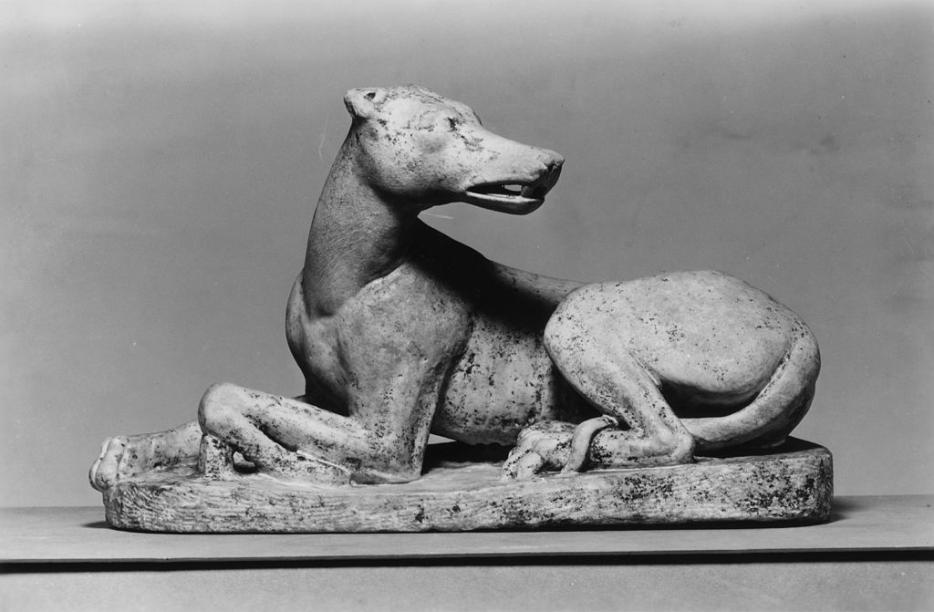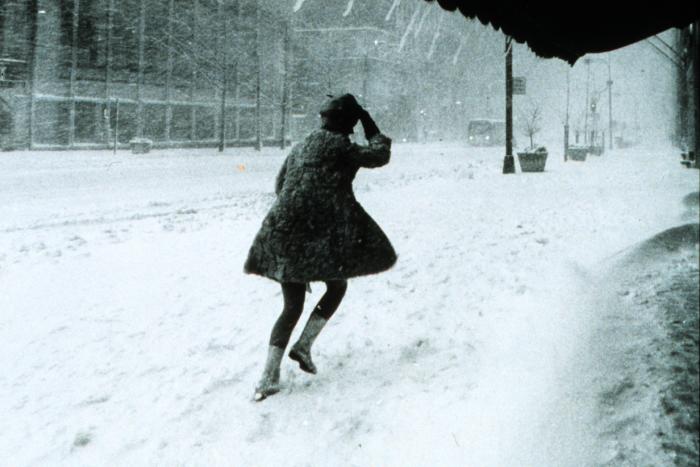You probably think you know dogs. By this I mean, when I read you a famous description of dogs, you will have the same feeling I did when I first read it. I said to myself: if the word “dog” had not appeared in the description, I wouldn’t have guessed which animal it was about; things look so new and special when a great scientist looks at them, as if they had never before been seen. The name of this scientist is Linnaeus, the very same Linnaeus you all know from botany and the man responsible for the system we still use today to classify plants. Here’s what he has to say about dogs:
Feeds on meat, carcasses, farinaceous grains, but not leaves; digests bones, vomits up grass; defecates onto stone: Greek white, exceedingly acidic. Drinks by lapping; urinates to the side, up to one hundred times in good company, sniffs at its neighbor’s anus; moist nose, excellent sense of smell; runs on a diagonal, walks on toes; perspires very little, lets tongue hang out in the heat; circles its sleeping area before retiring; hears rather well while sleeping, dreams. The female is vicious with jealous suitors; fornicates with many partners when in heat; bites them; intimately bound during copulation; gestation is nine weeks, four to eight compose a litter, males resemble the father, females the mother. Loyal above all else; house companion for humans; wags its tail upon master’s approach, defends him; runs ahead on a walk, waits at crossings; teachable, hunts for missing things, makes the rounds at night, warns of those approaching, keeps watch over goods, drives livestock from fields, herds reindeer, guards cattle and sheep from wild animals, holds lions in check, rustles up game, locates ducks, lies in wait before pouncing on the net, retrieves a hunter’s kill without partaking of it, rotates a skewer in France, pulls carts in Siberia. Begs for scraps at the table; after stealing it timidly hides its tail; feeds greedily. Lords it over its home; is the enemy of beggars, attacks strangers without being provoked. Heals wounds, gout and cancers with tongue. Howls to music, bites stones thrown its way; depressed and foul-smelling before a storm. Afflicted by tapeworm. Spreads rabies. Eventually goes blind and gnaws at itself.
That was Linnaeus. After a description like that, most of the stories frequently told about dogs seem rather boring and run-of-the-mill. In any case, they can’t rival this passage in terms of peculiarity or flair, even those told by people out to prove how clever dogs are. Is it not an insult to dogs that the only stories about them are told in order to prove something? As if they’re only interesting as a species? Doesn’t each individual dog have its own special character?
No single dog is physically or temperamentally like another. Each has its own good and bad tendencies, which are often in stark contradiction, giving dog owners precious conversation material. Everyone’s dog is cleverer than his neighbor’s! When an owner recounts his dog’s silly tricks, he is illuminating its character, and when the dog experiences some remarkable fate, it becomes something greater, part of a life story. It is special even in its death.
Now let’s hear about some of these peculiarities. It must also be true of other animals that they possess many unique qualities that are not found in the species as a whole. But humans make this observation so readily and definitively only with dogs, with whom they have a closer bond than with any other animal, except perhaps horses. It all began thousands of years ago with man’s great victory over the dog, or more precisely, over the wolf and the jackal; yielding to man, allowing themselves to be tamed, these wild animals became dogs. However, the most ancient dogs, which first appeared around the end of the Stone Age, were far removed from our pets and hunting dogs of today. They were more similar to the halfwild dogs of Eskimos, which have to fend for themselves for months at a time and resemble the Arctic wolf in every respect, as well as the fearful, treacherous, and currish dogs of Kamchatka, which, according to one traveler’s account, haven’t the slightest love for or loyalty to their master—in fact, they constantly try to kill him. The domesticated dog must have arisen from such a beast. It is truly regrettable that later on, some dogs, especially mastiffs, returned to their old savagery as a consequence of breeding, becoming even more dreadful and bloodthirsty than they had been in their primitive state. Here is the story of the most famous of all bloodhounds, named Bezerillo, whom the Spaniards of Fernando Cortez came upon while conquering Mexico, and then trained most hideously.
In earlier times the Mexican bulldog was used in the nastiest way. It was trained to catch people, tackle them to the ground, and even kill them. During the conquest of Mexico, the Spaniards deployed such dogs against the Indians and one of them, by the name of Bezerillo, became famous, or rather, infamous. It can no longer be said whether or not he was an actual Cuban mastiff, which is considered to be a mongrel of a bulldog and a bloodhound. He is described as mediumsized, red in color, but black around the nose and up to the eyes. His audacity and intelligence were equally extraordinary. He enjoyed the highest status among the dogs and received twice as much food as the others. When on the attack he would hurl himself against swarms of Indians while taking care to lock onto an arm so he could drag away a captive. If they complied, the dog would inflict no further harm; if they refused to accompany him, in a flash he would pin them to the ground and strangle them. He could tell exactly which Indians had capitulated and let them be, focusing instead on the resisters. Although so cruel and so fierce, he sometimes showed himself to be much more humane than his masters. One morning, so the story goes, Captain Jago de Senadza wanted to have a little barbarous fun by letting Bezerillo rip to shreds an old captive Indian woman. He gave her a letter and ordered her to deliver it to the governor of the island; the letter instructed that the dog be let loose on the old woman to rip her apart. When the poor, defenseless Indian woman saw the ferocious dog storming after her, she fell to the ground in fear, desperately begging him for mercy. She showed him the letter, explaining that she had brought it to the commander on orders. The ferocious dog hesitated at these words, and, after a moment’s contemplation, approached the old woman tenderly. This incident astounded the Spaniards, appearing to them as something mystical, or supernatural, which is probably why the governor set the old Indian free. Bezerillo met his end in a skirmish with Caribs, who felled him with a poison dart. It’s easy to see how the unfortunate Indians saw such dogs as four-legged abettors of the two-legged devil.
The following story tells of a breed of wild mastiff that roams in packs about Madagascar:
On the island of Madagascar, large hordes of dogs roam wild. Their bitterest enemy is the caiman, which would frequently devour them as they swam from one riverbank to the next. Over the years of struggle against the beast, the dogs have invented a trick that enables them to stay clear of the caiman’s jaws. Before diving into the water, they gather in a large group by the shore and bark as loudly as they can. Drawn to the noise, all the alligators in the vicinity raise their giant heads out of the water just below the spot on the bank where the pack is waiting. At this point the dogs gallop along the bank and then swim across the water unmolested, as the ungainly alligators are not able to keep up. It is also interesting to observe that dogs brought to the island by new settlers fall victim to the caiman, while their offspring later save themselves from certain death by employing the trick invented by the indigenous dogs.
We have seen that dogs know how to help one another. Now let’s see how helpful they’ve been to humans. I’m thinking of age-old human activities such as the hunt, the night watch, trekking, war, in all of which dogs have cooperated with humans, spanning various epochs of world history and the most remote corners of the Earth. Some ancient peoples, like those from Colophon, waged wars using great packs of dogs, who would attack first in all their battles. But I’m thinking not only of dogs’ heroism throughout history, but also of their roles in society, and the assistance they give people in countless aspects of everyday life. There is no end to the number of stories, but I will tell only three very short ones, the Boot Dog, the Coach Poodle, and the Death Hound.
At the Pont-Neuf in Paris there was a young bootblack who trained a poodle to dip her thick hairy paws in the water and then tread on the feet of passersby. The people would cry out, the bootblack would appear and thereby multiply his earnings. As long as he was busy shining someone’s shoes, the dog behaved, but when the footstool became free, the game would begin anew.
Brehm tells us about a poodle he knew whose intelligence brought great amusement. He was trained in all sorts of things and, in a manner of speaking, understood every word. Whatever his master sent him to fetch, he was sure to deliver what was asked. He would say: “Go fetch a carriage!” and the dog would run to the spot where the cabs wait, jump into a coach and keep barking until the carriage drove off; if the coachman took a wrong turn, the dog began barking again, and in some cases would even run along ahead of the wagon until they reached his master’s home.
An English newspaper reports: In Campbelltown in the province of Argyllshire, every funeral procession, with very few exceptions, makes its way from the church to the cemetery accompanied by a quiet mourner in the form of a huge, black dog. He always takes his place beside those immediately following the casket and escorts the funeral cortege to the grave. Once there, he lingers until the final words of the eulogy have come and gone. With much gravitas he then turns around and exits the graveyard at a solemn pace. This remarkable dog seems instinctively to know when and where a funeral will occur, as he always shows up just at the right moment. Because he has been shouldering this freely chosen obligation for years, his presence has become more or less expected, such that his failure to appear would be conspicuous. At first the dog was always chased from the open grave, his preferred spot to sit, but he would always return to accompany the mourners at the earliest opportunity. Eventually people gave up chasing away the quiet sympathy-bearer, and he has since had an official role in every funeral procession. However, the most remarkable thing was when a chartered steamer pulled into the harbor, carrying a recently deceased man and his attendant mourners: the dog waited right where the ship would dock and then accompanied the funeral procession to the cemetery in his usual way.
Incidentally, did you know there’s an encyclopedia of famous dogs? It was made by a man who busied himself with all sorts of obscure things. For instance, he compiled a lexicon of famous shoemakers, and wrote a whole book titled Soup, as well as other, similarly esoteric works. The dog book is very handy. Every dog known to man is in it, including some that the writer has conceived of himself. It was in this book that I found the wonderful and true story of Medor the dog, who took part in the Paris Revolution of 1831 and the storming of the Louvre, but lost his master there. I’ll tell it to you now in closing, just as its author Ludwig Börne wrote it.
I left Napoleon’s coronation for another spectacle that was more after my own heart. I visited the noble Medor. If virtue were rewarded with a title on this Earth, Medor would be the emperor of all dogs. Consider his story. After the storming of the Louvre in July, those who died in the battle were buried in the square in front of the palace, on the side where the delightful columns stand. When the bodies were laid onto carts to carry them to the grave, a dog jumped with heartrending sorrow onto one of the wagons, and from there into the large pit into which the dead were thrown. Great efforts were made to pull him out; he would have been scorched by the scattered lime even before being buried under the dirt. That was the dog people would later call Medor. During battle he always stood beside his master. He was wounded himself. Since his master’s death he never left the graves, moaning day and night before the door to the narrow cemetery, or howling while running back and forth in front of the Louvre.
No one paid much attention to Medor, because no one knew him or could guess his pain. His master must have been one of the many foreigners that came to Paris in those days, fought unnoticed for the freedom of his homeland, bled there, died there, and was buried anonymously. Only after several weeks did people begin to take notice of Medor. He was emaciated about the ribs and covered in festering wounds. People gave him food, but for a long time he refused it. Finally the persistent compassion of a good townswoman succeeded in alleviating Medor’s grief. She took him in, bandaged and healed his wounds, and made him strong again. Medor was more content, but his heart lay in his master’s grave, where his caretaker took him after his recovery and where he would stay for the next seven months. A few times greedy people sold him to rich curiosity seekers; once he was taken thirty hours from Paris, but he always found his way back. Medor is often seen unearthing a small piece of fabric; he becomes excited upon finding it and then sadly reburies it. It’s probably a piece of his master’s shirt. If he’s given a piece of bread or cake, he buries it in the ground, as if wanting to feed his friend in the grave, and then retrieves it, repeating this process several times a day. For the first few months the national guardsman at the Louvre would invite Medor into the guardhouse every night. Later on the guard saw to it that a hut was built for Medor beside the grave.
Medor quickly found his Plutarch, his rhapsodists, his painters. When I visited the square in front of the Louvre, peddlers offered me Medor’s life story, songs of his exploits, his portrait. For ten sous I purchased Medor’s immortality. The little graveyard was surrounded by a thick wall of people, all poor folks from the street. Here lies buried their pride and joy. This is their opera, their ballroom, their court, their church. They’re thrilled to get close enough to pet Medor. I too managed to edge my way through the crowd. Medor is a large, white poodle. I bent down to pet him, but he took no notice of me; my jacket was too fine. But when approached and stroked by a man in rough clothes, or a ragged woman, he responded warmly. Medor knows very well where to find the true friends of his master. A young girl, all in tatters, came to him. He jumped up to greet her, clung to her and wouldn’t let go. He was so happy, so at ease with her. To ask something of the poor girl, he didn’t need to first bend before her and touch the hem of her skirt as with a groomed and genteel lady. Wherever he bit at her dress was a rag that fit snug in his mouth. The child was very proud of Medor’s familiarity with her. I crept away, ashamed of my tears.
And with this we are through with dogs for the day.
An excerpt from Radio Benjamin, edited by Lecia Rosenthal and translated by Jonathan Lutes. Published by Verso Books.






